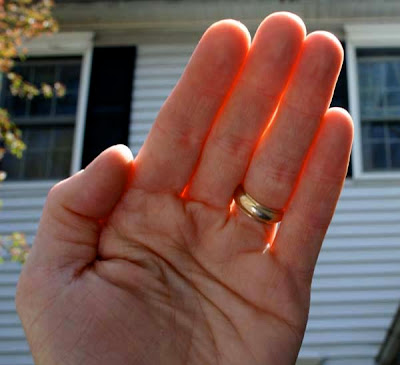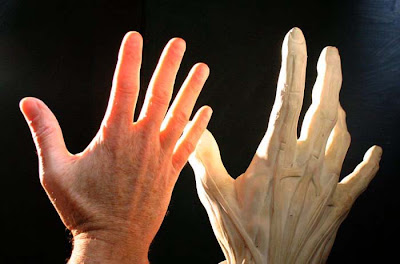 That’s because we’re getting roughly the same volume and quality of light bouncing off the surface in what’s called diffuse reflection. This accounts for only part of the light that touches the surface of the forms. What happens to the rest of it?
That’s because we’re getting roughly the same volume and quality of light bouncing off the surface in what’s called diffuse reflection. This accounts for only part of the light that touches the surface of the forms. What happens to the rest of it? If we turn things around so that the light is coming from behind, everything changes. The cow is darker because the dense plastic absorbs the light on the far side and there’s not much ambient light or reflected light filling the shadow on the near side.
If we turn things around so that the light is coming from behind, everything changes. The cow is darker because the dense plastic absorbs the light on the far side and there’s not much ambient light or reflected light filling the shadow on the near side.The orange section is practically incandescent. Light enters the transparent skin on the far side and bounces around inside the fruit, eventually reemerging through the surface. Note that the glow is brighter where the wedge is thinner.
This effect has the fancy name of “subsurface scattering.” It shows up most strikingly when three conditions are met: translucent flesh, small forms, and backlighting. It’s also present on the lit side; it’s just not as obvious.
 If you hold your hand up against the sun or against a bright flashlight at night, light traveling subcutaneously turns the spaces between your fingers bright red.
If you hold your hand up against the sun or against a bright flashlight at night, light traveling subcutaneously turns the spaces between your fingers bright red.Subsurface scattering is what makes a person’s ears turn crimson when they stand contre-jour. The effect is similar to transmitted light, which describes light traveling through thin membranous surfaces like leaves.
 Artists have known about this property for centuries. Peter Paul Rubens rendered skin not as an opaque surface, but as a transparent, glowing, luminous layer.
Artists have known about this property for centuries. Peter Paul Rubens rendered skin not as an opaque surface, but as a transparent, glowing, luminous layer. When academic students who have begun their training on plaster casts transition to the live model, they’re often amazed by the way skin glows, especially in the fingertips, nostrils, and ears.
When academic students who have begun their training on plaster casts transition to the live model, they’re often amazed by the way skin glows, especially in the fingertips, nostrils, and ears.Tomorrow we’ll see how subsurface scattering gives realism to sculptures, animatronics, and 3D animation.
--------
Continue reading at on the post Subsurface Scattering II. Related GJ posts: Transmitted Light and Contre-Jour Lighting
The Rubens is thanks to the Fine Arts Museum in Belgium, link:







6 comments:
For an in depth look at subsurface scattering it's worth reading Henrik Wann Jensen's papers as he, in the realm of computer graphics anyway, is the grand-daddy of all of this. Link.
It's really cool that you're covering some of this hard science here. Although I started out as a traditional fine artist I've ended up making CGI for films and I do find that the techniques and scientific theory I've learned doing VFX work feed back into my painting and drawing. It's quite a symbiotic relationship with ideas and theories from one field informing the other.
Thanks for that fascinating link. And I completely agree with you about how the pioneering work of the CGI people really benefits traditional painters.
Being from Antwerp, this is the best post ever, because it features a face painted by a neighbour of mine - my good friend Peter Paul!
In fact this head he painted is one of my all time favorite painted faces.
It's from a biblical scene and portrays a (hypocritical) high priest, confronting Jesus with an adulterous woman, which lead to Jesus proclaiming the famous words "Let him who is without sin cast the first stone".
Should pay my good neighbour a visit.
Haven't seen him for a while - since...1640 I think.
I wonder how large an object can get before this effect starts to break down? Or if there are any particularly large objects that show subsurface scattering?
Is this the same effect that I'm seeing when I look, for instance, at my opaque bathroom window, which simply shows an evenly distributed glow when backlit? Or is subsurface scattering specific to fleshy objects?
Sorry--I'm full of questions today! This is interesting, though...now I kind of want to do enormous paintings of backlit orange slices...
A. fortis: The classic materials for subsurface scattering are skin, wax, marble, jade, and milk. The idea is that the material should have some volume, so that you can see how far the light travels into it. How big? I suppose a huge iceberg could scatter light pretty far inside.
A translucent bathroom window or a backlit leaf or a piece of stained glass is similar, but that falls more into the category of "transmitted light" since it's more two-dimensional.
Thanks!
-Sarah
Post a Comment